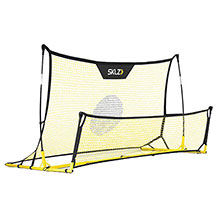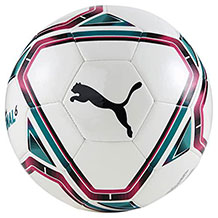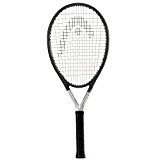Table tennis table purchasing advice: how to choose the right product
- The most important facts in brief
- There are table tennis tables for indoor and outdoor use as well as tables for recreational and tournament use.
- The level and frequency of play determine the decision for a recreational, training or competitive table tennis table.
- Professional table tennis tables must comply with the ITTF standard in order to be certified for participation in competitions.
- Many models can be folded to save space or moved thanks to castors.
- The room in which the table is set up should be at least 30 square metres.
Small ball, long range
Table tennis is one of the most popular sports in Germany. The tables can be found in many gardens, garage driveways and cellars, and there is probably hardly anyone who has not tried their hand at playing with the little racket.
Table tennis conquers the world
In this country, the sport began its triumphal march at the beginning of the 20th century. This makes table tennis almost as old as football, Europe’s number one sport. In the 1920s, the German Table Tennis Federation was founded and the first championships were held. Today, table tennis is a sport for everyone and can be played wherever there is room for the table that gives it its name – whether in the garden at home or in a table tennis club.
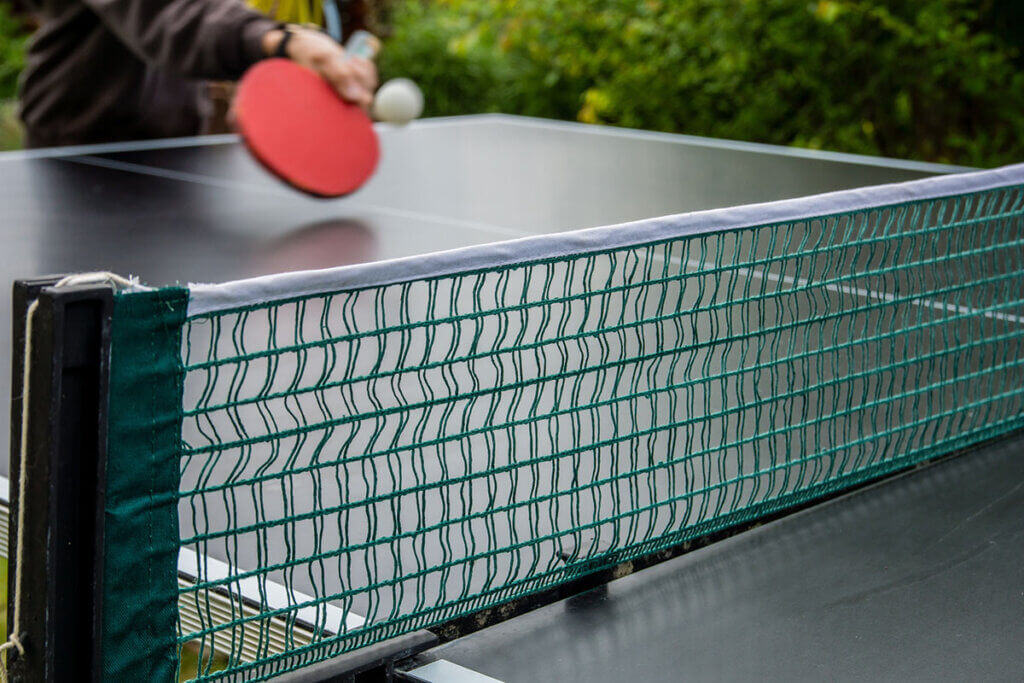
Since 1988, the sport has even been Olympic. The all-dominant nation in world table tennis has been China for over half a century. The country promotes the sport and regularly produces new world champions and Olympic winners. But the game was invented elsewhere: just like football, table tennis has its origins in Great Britain. The English aristocracy, who were spoilt for leisure, did not want to do without their beloved tennis in rainy weather, so the game was moved indoors without further ado. For lack of sufficient space, tables pushed together were used as courts. A rope served as a net and books and pans were converted into rackets. Table tennis as we know it today quickly developed from this “room tennis”. The first rules were introduced as early as 1875. From the end of the 19th century, the sport became established and quickly attracted a wide range of players.
Construction of a table tennis table
A good table tennis table is not cheap, but it is usually a long-term purchase, which is why the investment pays off. Table tennis tables can be used quickly and flexibly – provided that the necessary space is available and the table is already assembled. If you are setting up a table tennis table for the first time, you should take your time, have sufficient tools and a helping hand at your side.
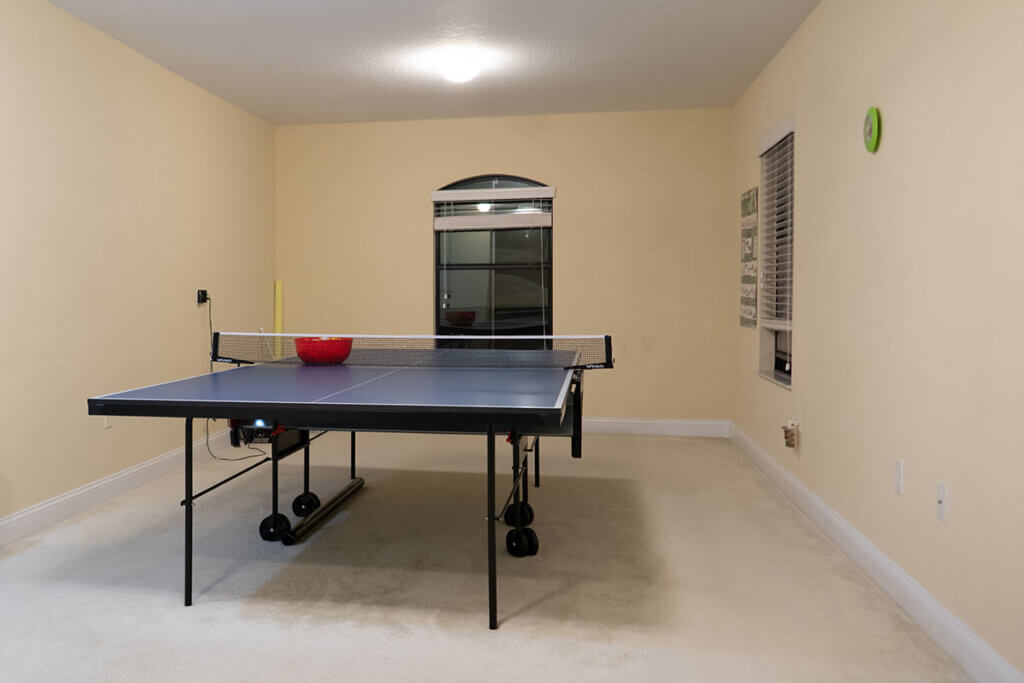
A table tennis table consists of the table itself, a frame, a frame and a net. For one person alone, it can quickly become complicated to assemble the individual components properly for reasons of coordination. But in principle, the demands on craftsmanship are not excessively high. On average, it takes about an hour to set up the new table tennis table ready for use.
The ideal location
Once assembled, many models can be folded up after use to save space or moved thanks to attached castors. So if you don’t have room to leave the table tennis table permanently, you can store it somewhere else and bring it out again for the next game.
Sufficient space is needed not only for setting up the table, but also for the game itself – on the one hand to guarantee enjoyment and on the other to prevent accidents. The perfect room for setting up a table tennis table measures about 30 square metres and is preferably dry and brightly lit. Therefore, the future location of the table tennis table should be well chosen. Depending on the level of play, a lot of free space is needed when playing, as players sometimes stand one to two metres away from the edge of the table. Perhaps the table tennis table is also intended for children who like to play “round robin” games around the table.
For the location of the table tennis table, it is advisable to consider the following criteria:
- Allow at least 2.0 metres of free space on both playing sides.
- Keep 1.5 to 2.0 metres free on the long sides.
- The ceiling height should be at least 2.5 metres.
- Good lighting conditions are advantageous for the game.
The different types
Table tennis tables can be divided into outdoor and indoor models on the one hand and whether they are used for recreational purposes, in clubs or at tournaments and official competitions on the other. The boards are 274 centimetres long, 152 centimetres wide and 76 centimetres high. The net measures 183.00 centimetres in length and 15.25 centimetres in height. The dimensions comply with the ITTF standard, set by the International Table Tennis Federation. This means that a table tennis table is competition-certified.
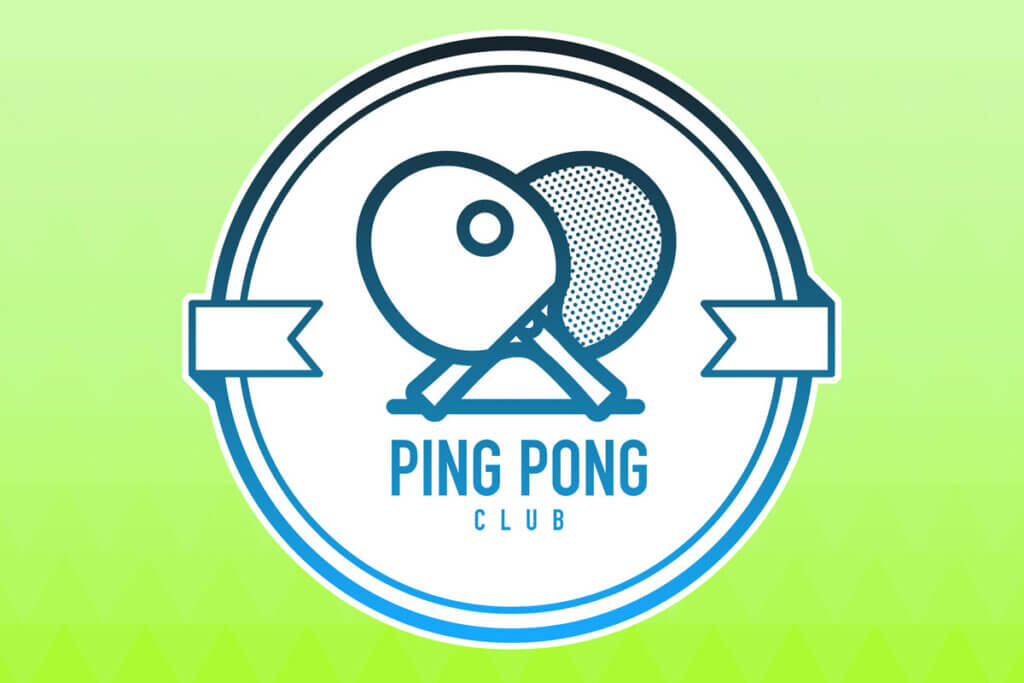
In the recreational sector, the dimensions occasionally deviate. The most noticeable difference to professional table tennis is the thickness of the tabletop, which determines the intensity of the ball bounce. It is between 25 and 30 millimetres for professional boards, but between 15 and 22 millimetres for amateurs.
Which table tennis table is right for me?
Indoor table tennis tables should only be set up indoors, as they are not weatherproof. A recreational table tennis table is cheaper, but not on the same level as a training or competition table in terms of quality and playing characteristics. If you have little space available, a mini table tennis table could be the solution. Outdoor table tennis tables often do not have a fixed location. They are set up or taken down depending on use or weather conditions. Therefore, it is advisable to choose a table tennis table that can be folded or has wheels. Only table tennis tables for public use are permanently mounted on the ground. These are usually made of concrete, which is why they can withstand the weather. They are suitable for public squares or schools as well as private gardens.
The level decides
In addition to deciding between an indoor or outdoor table tennis table, the level at which you play is the most important factor when choosing a table tennis table. Below you will find a few additional decision-making aids:
Recreational tables are suitable for occasional play at hobby and amateur level. The tops are usually very simply finished and less than 20 millimetres thick.
Training tables are recommended for regular, semi-professional play; for example, in clubs and schools. They have better playing characteristics and are solidly made. The tabletop thickness is between 19 and 22 millimetres.
Competition tables are ideal for professional athletes. They are competition-certified according to the current ITTF standard, offer excellent playing characteristics and are very robust. High-quality boards are 25 to 30 millimetres thick.
What matters when buying
First and foremost, the quality of the table tennis table is crucial. In addition to the material, the certification, the weight, the basic equipment, the accessories and the price also play a role when buying.
Material
Outdoor tables have the advantage that they can be set up both indoors and outdoors. However, the weatherproof boards made of aluminium or melamine resin coatings are of lower quality in terms of playing characteristics: The material influences the bounce of the ball, for example. Indoor table tennis tables are made of higher quality material. The boards are made of fine tension and are therefore easier to play on, but must never be exposed to moisture or sunlight.
More frame for more stability
The wider the frame of the table tennis table, the more stable the playing surface. This has a positive effect especially on an uneven or wobbly location of the table.
Competition certification and ITTF standard
In order for a table tennis table to meet the demands of professional table tennis under competition conditions, it must fulfil certain requirements and comply with the ITTF standard. The ITTF determines which criteria make a table tennis table a competition certified table.
Apart from the already mentioned standard dimensions for a professional table tennis table, these guidelines mainly concern the processed material. Although it is not specifically stated which material may be used in the manufacture, the material properties are clearly explained. A table tennis ball dropped from a height of 30 centimetres must bounce at least 22 to 25 centimetres, regardless of the point on the table. The sliding friction is also precisely defined. In addition, table tennis tables must always be green or blue for competitions. The plate should be of a uniform and matt colour so that light reflections are avoided. Likewise, the inscriptions on the tabletop are regulated. If a table tennis table meets all the stipulated regulations, it receives the ITTF seal and can be used in competitions.
In Germany, a table tennis table must comply with the DIN EN 14468 standard. This requires approval by the German Table Tennis Association (DTTB). Manufacturers have had to apply to the Federation for approval of their tables since 1995.
Weight
Outdoor table tennis tables weigh between 50 and 70 kilograms. They are usually 10 to 20 kilograms lighter than comparable indoor tables. Depending on the model, these can weigh 100 to 120 kilograms. Many models also have a folding mechanism or removable castors so that the table tennis tables can be quickly and easily stored or put away.
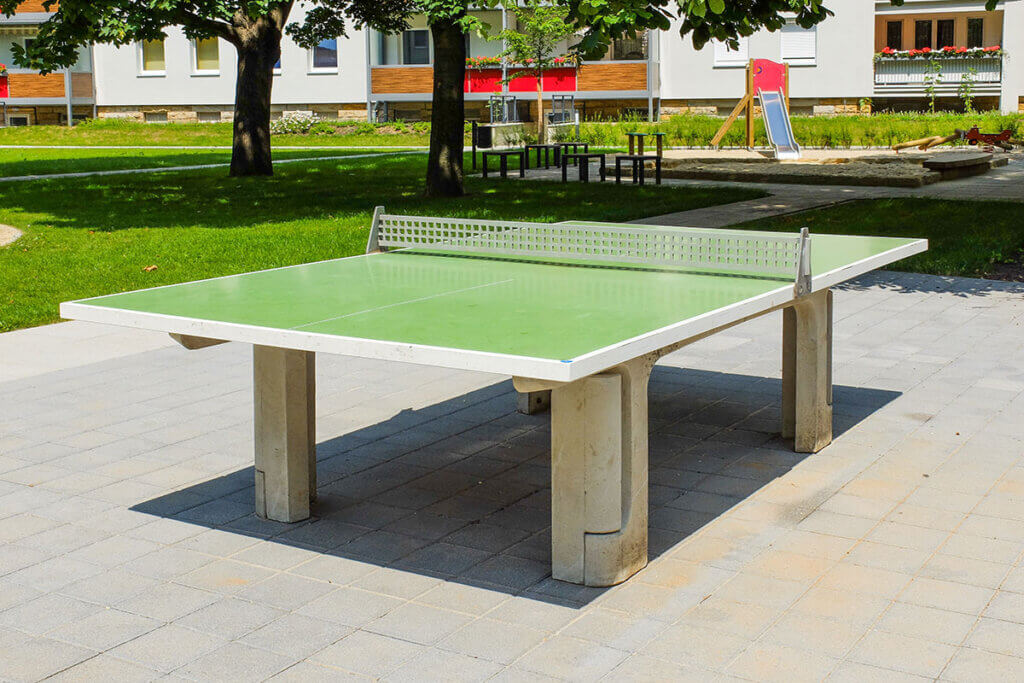
Basic equipment
A table tennis table is incomplete without a table tennis net, so it is usually included in the purchase. The net tension ensures that the net does not sink more than 10 millimetres under a load of 100 grams. With an outdoor table tennis table, the net should of course also be weatherproof. You usually have to buy bats and balls separately. Table tennis bats are mainly made of wood and coated with rubber on both sides. Depending on the direction of play, the models are divided into the categories “all-rounder”, “defensive” and “offensive”. Table tennis balls are made of celluloid or plastic. They measure 4 centimetres in diameter and weigh 2.7 grammes. The bounce of the balls is of central importance: If a ball is dropped from a height of 30 centimetres, it must bounce 22 to 25 centimetres; only then does it meet the playing standard. There are hardly any limits to the quality and price of rackets and balls.
Accessories
A cover for the table tennis table is recommended. Regardless of whether it is an outdoor or indoor table, a cover protects against wind and weather as well as dust or liquids. This guarantees a longer service life. Ball holders are practical so that the balls do not have to be stored in pockets and are always at hand. Covers for rackets are also useful to protect them from dirt. A suitable cleaning set for racket and plate is also important. If you want to play the sport professionally, you should also wear sportswear when playing table tennis. A functional shirt is very comfortable to wear and inhibits the flow of perspiration. There are also specially designed table tennis shoes that support quick stopping when moving.
Table tennis robots to help
If you can’t find a sparring partner or want to practise special playing techniques, you can use a table tennis robot. This is attached to the edge of the table opposite and simulates the opponent.
Price
The price range is relatively wide due to the different designs. Depending on whether you opt for a simple leisure version or a table suitable for competition, a table tennis table costs between 150 and 2,500 euros. Even if you use the table in your free time and play as an amateur hobby, you should invest at least 300 to 400 euros to get a solid table in the medium quality segment. If you play table tennis at club level or even professionally and therefore need a training or competition table, you will have to dig a little deeper into your pocket. A high-quality, competition-certified professional table tennis table costs at least 750 euros – the price range is open at the top.
Careful handling and regular cleaning
Proper cleaning of the table tennis table guarantees the preservation of the playing characteristics as well as a long service life. With the right care and careful handling, a table tennis table can be used for many years. Outdoor tables in particular should be covered with a protective cover when you are not using the table. In addition, you should always store the table tennis table in a dry, wind-protected and dark place, preferably indoors such as a shed, garage or cellar. Remember: The table tennis table is not a table – you should keep drinking bottles, food, clothing or other utensils away from the playing surface.
If the table tennis table is soiled by dust and sweat – or, in the case of outdoor tables, by leaves and precipitation – you should wipe it carefully with a damp, gentle cloth. In this way, you can guarantee that the table will retain its playing characteristics. If there are more stubborn residues, you can use a simple glass cleaner. After cleaning, you should dry the board.
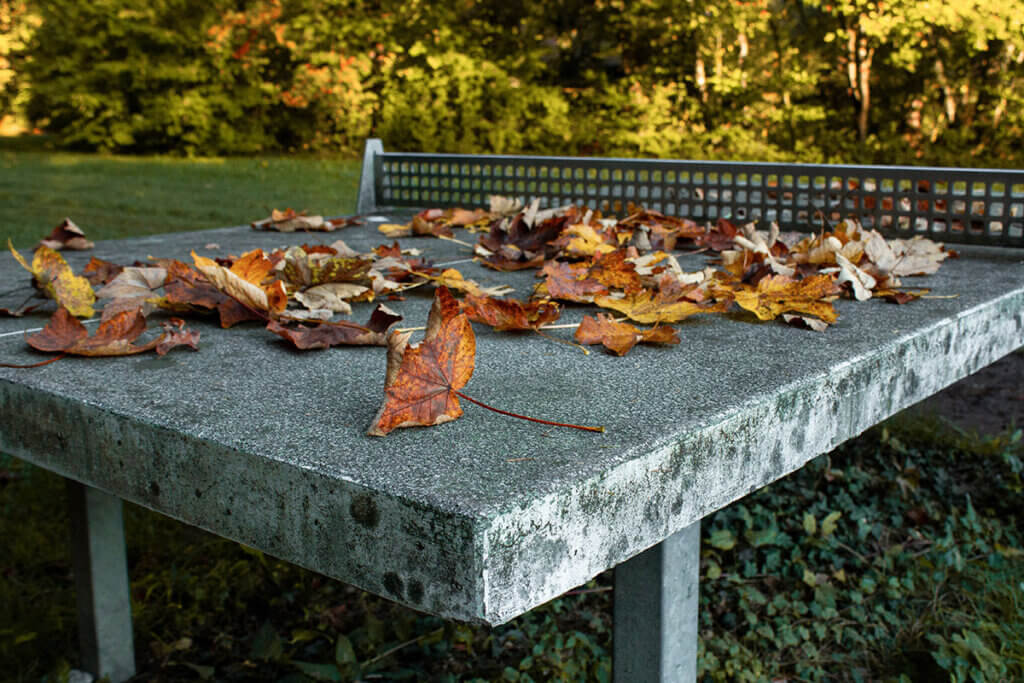
The DTTB and the rules
We can only speculate about the number of people in Germany who pick up a table tennis bat in their spare time. It will certainly be several hundred thousand, if not more. Around 550,000 table tennis players are organised at club level alone. These semi-professional players are active in almost 10,000 clubs, which are divided into 20 state associations and 8 regional associations. The German Table Tennis Federation, or DTTB for short, acts as the umbrella organisation and looks after the interests of domestic table tennis. It organises the annual national championships and represents German table tennis in legal matters. In addition, the World Table Tennis Championships are held annually: in odd years the World Singles Championships, in even years the World Team Championships.
The DTTB also watches over the observance of the table tennis rules. According to the current rules, a table tennis match lasts a minimum of three and a maximum of five sets. The first player to win three sets wins the match. A minimum of eleven points is required to win a set. If both players are tied at 10:10, the first player to win by two points wins the match. A draw decides at the beginning on the serve and on which side to start. The side is changed after each set. The ball is thrown vertically at least 16 centimetres into the air with the open hand when serving. This must be done behind the plate. The ball touches one’s own side and then the opponent’s side during the serve. If the ball touches the net, the serve must be repeated. As in football, yellow and red cards are handed out in table tennis if players do not follow the rule.
The ball may not be hit directly out of the air, but must first touch the player’s own side of the board. During the game – i.e. not during the serve – it may come into contact with the net. If the ball hits the players themselves, the ceiling or walls, it is considered a fault. While the edges of the table tennis table are still considered a playing surface, the sides are not an official surface. Players are also not allowed to lean on the table while playing, for example to get a better grip on the ball.
Fig. 1: © SKatzenberger / stock.adobe.com | Fig. 2: © Feng / stock.adobe.com | Fig. 3: © annecelinemoisan / stock.adobe.com | Fig. 4: © Torsten Becker / stock.adobe.com | Fig. 5: © Steve / stock.adobe.com

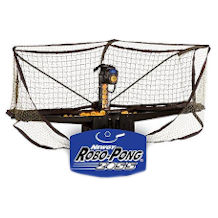
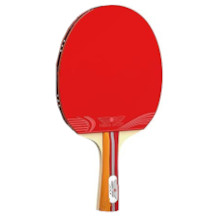
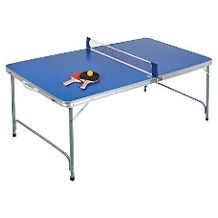

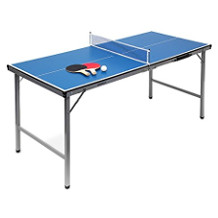
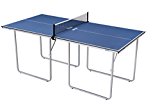
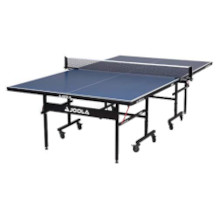
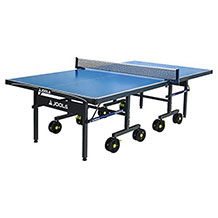
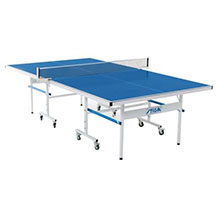
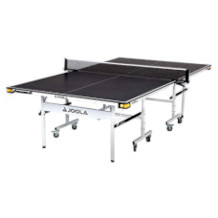

 298 reviews
298 reviews

